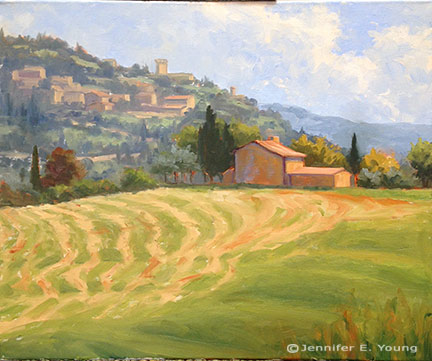Finally complete- Tuscan Hay painting
/I'm taking a break from chopping my vegetables to finally wrap up the latest Tuscany painting I left flapping in the breeze on New Year's Day. After I had my composition established and my canvas covered, it was time to go back in to further develop the background, middle ground, and foreground. It sounds very systematic, but this was really more of a back and forth dance because the value, scale, edges, etc. all have to relate and are interdependent with the other elements in the painting. For instance, in the image below, I thought I had the background fairly finalized...until I took a step back and decided the buildings were too large and too prominent in relation to my foreground house. As I moved forward to the center of interest it became apparent that these two areas of the painting were battling for attention. So I went back and softened the distant village and reduced the size and contrast of the buildings a bit more, and further softened their edges.
Here's the final:
























